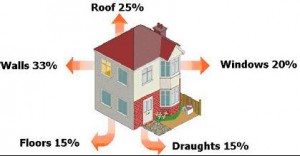The poster-boy for renewable energy of photovoltaic cells is no panacea. If we carpeted every roof in the country it would make a reduction of 9% of current carbon emissions (Monbiot-January 2012). That doesn’t mean it is not worth doing. 9% is a good start. Transition is different to the big engineering solution people tend to think of – “Small is beautiful” says Schumacher.
So what could we do as well?
Very often the engineering solutions proposed for the tackling of climate change concentrate on fuel efficiency, that is, doing what we do already, but using less fuel, or using the same fuel, but reducing the greenhouse gas emissions. All this does is slow down fuel burning: eventually we’ll still burn it all and run out. The solution is to stop using fuel to solve our problems, by living on a lot less energy, using several other kinds of energy, using a spread of materials, using the waste products for something else and stewarding the ecosystem. The environment has more energy for us and more ways to use up our waste – if we look around.
Heating & Insulation
The biggest reduction we can make in emissions from energy generation is to reduce the energy demand. Roughly one third of our energy use is in heating water and air, one third is transportation and one third for everything else (including making things and growing food). So redesigning and insulating all the buildings where we live, work or play gives us a huge scope for reducing demand.
Better insulation and draught-proofing is a good start. A lot of energy is lost through the floors, walls, windows and roofs of our houses. The less heat that can escape means that less is needed to warm the air & water up. The retro-fitting of the entire domestic housing stock is a big job. The rate of house demolition and construction is relatively low. Even if all new houses come with very good insulation, it will take 100 years or more to replace every single house. So we need to convert the existing houses as soon as possible too.
Economists tell us that rational people decide to change their behaviour when the price signal tells them. Maybe they would – if they have a long-term rational mindset, a lot of spare cash to invest, and that they know how to go about retro-fitting. In reality whatever the price of heating changes to, we just pay it and complain, but don’t retro-fit. So we now have people still living in under-insulated houses and just getting poorer.
Retro-fitting will fairly quickly give homeowners (and renting tenants) a clear saving over time. It is an investment offering 6% returns or more on a risk-free on-going basis and with gas prices likely to rise it will just get better. If banks could be persuaded that this is a useful, low risk investment with good returns we could be doing this all over the country.
New Construction
 Industrial buildings are often made in order to look impressive, and often out of concrete with steel & glass facades. These buildings are cheap to build, look impressive and generate big profits for their builders.
Industrial buildings are often made in order to look impressive, and often out of concrete with steel & glass facades. These buildings are cheap to build, look impressive and generate big profits for their builders.
But the air inside such a space is expensive to heat in winter and cool in summer. There are many techniques for building in order to require next to no energy to heat in winter and cool in summer.
Energy is not only used to heat buildings, but to build them and knock them down again. The techniques used in western construction give off large amounts of greenhouse gases and take lots of energy, in the transportation, the making of cement, glass and metal.
Glass, steel and concrete take large amounts of coal to produce. Concrete emits lots of carbon dioxide in its production, and as it dries out. Cob, lime rendering, rammed earth and adobe do not require anywhere near as much energy to produce, and since the materials are generally near to hand, transportation is hardly necessary. The more fashionable materials’ original location in modern construction is a minor concern, and transportation volumes and distances are huge. Since these materials are also very heavy, this transport presents a major demand on the transportation energy budget.
In brown field development there is usually a huge amount of building material in situ, which can be used for landscaping, or as road or rail ballast. There is a reduced need to dispose of the material and a reduced need to buy and carry in new material. With a little creativity you can get a long way.
 Wood is used in modern construction in huge quantities, often just for the shuttering as part of the process of building with concrete. Typically the wood is tropical hardwood, taken from virgin rainforest, leaving a wake of destruction. Once the loggers find some forest, other industries follow, with farming, and within 2 years the forest and topsoil is gone, leaving a wasteland.
Wood is used in modern construction in huge quantities, often just for the shuttering as part of the process of building with concrete. Typically the wood is tropical hardwood, taken from virgin rainforest, leaving a wake of destruction. Once the loggers find some forest, other industries follow, with farming, and within 2 years the forest and topsoil is gone, leaving a wasteland.
Loggers fail to respect boundaries, laws and governments. Whilst there is such a demand for hardwoods, this practice will continue, and construction is a big demand. By avoiding the use of such wood, and maintaining strict standards, low volume and high priced hardwood for specialist high-skill uses, tropical rainforests can be maintained, and the local forest dwellers use the money as income to protect these precious ecosystems.
Locally sourced wood of the right variety, can replace metal for load bearing. Round wood avoids the energy requirement for sawing, and the waste, since wood grows in circles, not square timbers. Wood can be sawn in small sawmills with wood fired engines, as the waste wood becomes the fuel for the saw, and the carbon dioxide emitted by the mill is absorbed back into the living trees. This is true only if the forest is maintained or growing.
Throughout history, buildings were made using locally sourced materials, including stone, unless none can be found. This used to be out of necessity, but it provided sites with a local flavour. As long as stone can be quarried locally, its unique properties and local flavour produce attractive high quality construction without high energy needs, since the distances involved are so small. So, since we have all done this before, we do not need to come up with radically new methods, just relearn the old ones.
Buildings made fashionably, with high energy needs, become obsolete quickly, and run up high repair and maintenance costs, because of the need to build cheaply but sell expensively. Hence, the building either has to be renovated often, at high cost, or demolished and the land redeveloped. This strategy is costly in terms of energy and materials, leading to more transportation, mining, energy and even money.
The construction industry is likely to strongly oppose these changes, but once made, as long as there are people there will be need for an industry that will maintain, refit, repair, insulate, and modify buildings. If buildings can be designed to be modified rather than rebuilt, to counter the ravages of time or include new technologies as yet unknown, the costs and energy needs shall be lower.




